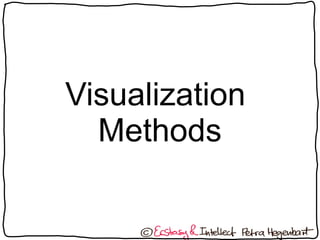Visualization Methods
- 3. This is a text. It is a string of words that are put one after another based on a system of rules called grammar. As you read along you try to make sense of what you read and you might make pictures in your mind to remember what was being said at the beginning and to figure out where this is all leading to. If you have a short attention span, however, you might have already forgotten what was said at the beginning and you could also get lost in the details and miss the complete picture. Besides, these black marks on white paper look ... well, they look rather dull. Because of this and for other reasons and to make a long story short, we like to visualize information
- 4. This is a text. It is a string of words that are put one after another based on a system of rules called grammar. As you read along you try to make sense of what you read and you might make pictures in your mind to remember what was being said at the beginning and to figure out where this is all leading to. If you have a short attention span, however, you might have already forgotten what was said at the beginning and you could also get lost in the details and miss the complete picture. Besides, these black marks on white paper look ... well, they look rather dull. Because of this and for other reasons and to make a long story short, we like to visualize information VISUALIZING INFORMATION BENEFITS: â reveal the big picture AND the detail â show relationships between the parts â >literally< more exciting to our brain VISUALIZING INFORMATION BENEFITS: â reveal the big picture AND the detail â show relationships between the parts â >literally< more exciting to our brain
- 5. Mindmaps â Probably one of the better known tools â Was used in antiquity already but was made popular by Tony Buzan in the 1970s â Works really well to visualize hierarchical structures or parts- of-a-system overviews (eg. Book contents, etc.)
- 7. Mindmap displaying a Hierarchy Map by James Kennedy
- 8. Concept Maps â If it is necessary to spell out the relationships between the nodes of a mindmap, you call it a concept map â Some mindmapping software allows you to do that (eg. TheBrain)
- 9. Antique concept map Source: Wikimedia, Author Anonymous
- 11. Visual Brainstorming â As strange as it sounds, your mind thrives on limitations; where a blank page can be intimidating, this technique can help:
- 12. Visual Maps â With the rise of Graphic Facilitation, there are more and more visual map templates that visually chunk information (eg. Business Model canvas, etc.) â Others use a metaphor to get people to associate and create a story around their topics
- 14. Sketchnotes â Visual notes made of a speech, video, article, book, your own thoughts etc. â (mainly) made popular by Mike Rohde â Great for retaining information but depending on the design might only make sense to the one who created it
- 16. Word-Pictures
- 17. Visual Map Map by James Kennedy
- 18. Visual Map (detail) Map by James Kennedy
- 20. Graphs and Diagrams â Graphs and diagrams can be used in a figurative sense rather than a number sense â âself-helpâ visualizations (cf. The Decision Book, Krogerus&Tschaeppler)
- 21. When to use what? â Who is it for? (Yourself or other people?) â What is for? (Purpose? Exploration, planning, retaining information, education, persuasion, etc.) Good questions to ask yourself about your visualization: â How memorable is it? â How conclusive is it?
- 22. Visual Metaphor âTime °ųģÜēÔēõâ






















